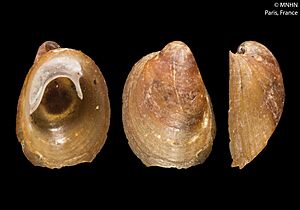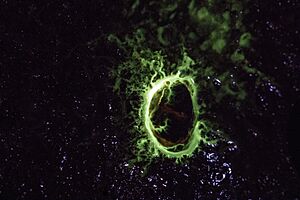Latia neritoides facts for kids
Quick facts for kids Latia neritoides |
|
|---|---|
 |
|
| Latia neritoides shells (syntype at MNHN, Paris) | |
| Conservation status | |
| Scientific classification | |
| Kingdom: | |
| Phylum: | |
| Class: | |
| (unranked): | |
| Superfamily: |
Chilinoidea
|
| Family: |
Latiidae
|
| Genus: |
Latia
|
| Species: |
L. neritoides
|
| Binomial name | |
| Latia neritoides Gray, 1850
|
|
| Synonyms | |
|
|
Latia neritoides is a very special type of small freshwater snail. It is also called a limpet. This amazing creature is an aquatic gastropod mollusc and belongs to the family Latiidae.
The first official example of this snail, called the type specimen, is kept in the British Museum.
The name "neritoides" means "like a nerite". Even though its name suggests it looks like a nerite snail, its shell actually looks more like a Crepidula shell. It has a unique shelf inside its shell.
Where It Lives
This snail is found only in the North Island of New Zealand. This means it is endemic to that area. You won't find it naturally anywhere else in the world!
Its Home
The Latia neritoides limpet lives in clean, flowing streams and rivers. It needs fresh, moving water to survive.
What Its Shell Looks Like
The shell of this snail can grow up to about 11 mm long. That's a little less than half an inch. It can be up to 8 mm wide and 4.5 mm tall.
The shell is shaped like a half-oval. It is thin and can break easily. Its color ranges from pale to dark brown. You can often see through it a little bit.
If you look closely, you might see tiny lines on the shell. These include very small lines that spread out like rays. There are also fine, close lines that show how the shell grew over time.
The very tip of the shell, called the apex, is usually at the back. It might stick out a bit past the edge. The opening of the shell, called the aperture, is large and oval. The inside of the shell is smooth and shiny.
Amazing Bioluminescence
One of the most exciting things about Latia neritoides is that it can glow in the dark! This is called bioluminescence. It also stays glowing for a while after it lights up, which is called phosphorescence.
You can easily see this light if you disturb the snail in the dark. If something scares it, like a crayfish or an eel, it will release a glowing slime. This slime is its way of defending itself from predators.
This snail is the only known freshwater gastropod that can make its own light. The light comes from a special chemical reaction. A substance called Latia luciferin is involved. This reaction is helped by an enzyme called luciferase and a purple protein.
See Also
- Quantula striata, the only known land snail that can glow.




